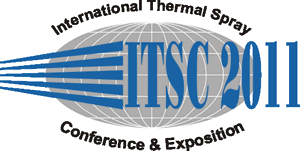
|
2984 |
|
Development of thermal barrier coatings with fine columnar crystal structure deposited by supersonic atmospheric plasma spraying |
|
Yu Bai / Xi'an Jiaotong University, China Zhi Hai Han/ Xi'an Jiaotong University, China Hai Jun Wang/ National Key Laboratory for Remanufacturing, China Chu Hua Ding/ Xi'an Jiaotong University, China Bin Shi Xu/ National Key Laboratory for Remanufacturing, China |
|
In this paper, the research progress of the 8 wt. % Y2O3 stabilized ZrO2 (8YSZ) thermal barrier coatings (TBCs) with fine columnar grains fabricated by supersonic atmospheric plasma spraying (SAPS) was presented. The in-flight velocity of molten particles was monitored by Spray Watch 2i. The results revealed that the in-flight velocity of molten particles in the SAPS was about 400-450m/s, 2-3 times as much as that (130-220 m/s) in conventional APS. And the finer structure can be obtained easily during the SAPS, since the impact velocity of molten particles was over the acoustic speed relative to the APS-TBCs. The axial length of columnar grains were in the range of 1~5 µm while the porosity of as-sprayed coating can be controlled from 1 % to 12 %. The unique structure of SAPS-TBCs was responsible for their greatly improved thermal cycling lives. The results of water-quenching test from 1100 °C into room temperature showed that SAPS-TBCs presented the higher thermal shock resistance, the cycle number at which about 10% spallation of the coatings can be observed was about 400, 2-3 times as much as that of conventional APS-TBCs (less than 150 cyc.). And the high temperature oxidation test on the fully coated samples at 1100 °C for 1000 h demonstrated the anti-oxidation performance of SAPS-TBCs was superior to that of APS-TBCs. Since SAPS spraying shows some advantages, which are similar to the APS, such as low cost and high efficiency, it is expected to be applied in aero industry in the future. |